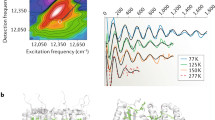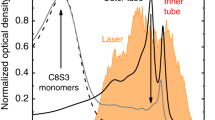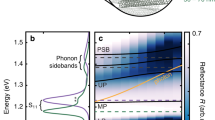Abstract
Quantum-coherent intermolecular energy transfer is believed to play a key role in light harvesting in photosynthesis and photovoltaics. So far, a direct, real-space demonstration of quantum coherence in donor–acceptor systems has been lacking because of the fragile quantum coherence in lossy molecular systems. Here, we precisely control the separations in well-defined donor–acceptor model systems and unveil a transition from incoherent to coherent electronic energy transfer. We monitor the fluorescence from the heterodimers with subnanometre resolution through scanning tunnelling microscopy induced luminescence. With decreasing intermolecular distance, the dipole coupling strength increases and two new emission peaks emerge: a low-intensity peak blueshifted from the donor emission, and an intense peak redshifted from the acceptor emission. Spatially resolved spectroscopic images of the redshifted emission exhibit a σ antibonding-like pattern and thus indicate a delocalized nature of the excitonic state over the whole heterodimer due to the in-phase superposition of molecular excited states. These observations suggest that the exciton can travel coherently through the whole heterodimer as a quantum-mechanical wavepacket. In our model system, the wavelike quantum-coherent transfer channel is three times more efficient than the incoherent channel.
This is a preview of subscription content, access via your institution
Access options
Access Nature and 54 other Nature Portfolio journals
Get Nature+, our best-value online-access subscription
$29.99 / 30 days
cancel any time
Subscribe to this journal
Receive 12 print issues and online access
$259.00 per year
only $21.58 per issue
Buy this article
- Purchase on Springer Link
- Instant access to full article PDF
Prices may be subject to local taxes which are calculated during checkout





Similar content being viewed by others
Data availability
Source data are provided with this paper. All other data that support the findings of this study are available from the corresponding authors upon reasonable request.
Code availability
The code used to calculate the results shown in this work is available from the corresponding authors upon reasonable request.
References
Scholes, G. D., Fleming, G. R., Olaya-Castro, A. & van Grondelle, R. Lessons from nature about solar light harvesting. Nat. Chem. 3, 763–774 (2011).
Romero, E., Novoderezhkin, V. I. & van Grondelle, R. Quantum design of photosynthesis for bio-inspired solar-energy conversion. Nature 543, 355–365 (2017).
Hedley, G. J., Ruseckas, A. & Samuel, I. D. Light harvesting for organic photovoltaics. Chem. Rev. 117, 796–837 (2017).
Dorfman, K. E., Voronine, D. V., Mukamel, S. & Scully, M. O. Photosynthetic reaction center as a quantum heat engine. Proc. Natl. Acad. Sci. USA 110, 2746–2751 (2013).
Förster, T. in Modern Quantum Chemistry (ed. Sinanoglu, O.) 93–137 (Academic, 1965).
Olaya-Castro, A. & Scholes, G. D. Energy transfer from Förster–Dexter theory to quantum coherent light-harvesting. Int. Rev. Phys. Chem. 30, 49–77 (2011).
May, V. & Kühn, O. Charge and Energy Transfer Dynamics in Molecular Systems (Wiley, 2011).
Govorov, A., Martínez, P. L. H. & Demir, H. V. Understanding and Modeling Förster-type Resonance Energy Transfer (FRET): Introduction to FRET, Vol. 1 (Springer, 2016).
Yun, C. S. et al. Nanometal surface energy transfer in optical rulers, breaking the FRET barrier. J. Am. Chem. Soc. 127, 3115–3119 (2005).
Deng, R., Wang, J., Chen, R., Huang, W. & Liu, X. Enabling Förster resonance energy transfer from large nanocrystals through energy migration. J. Am. Chem. Soc. 138, 15972–15979 (2016).
Diehl, F. P. et al. Emergence of coherence through variation of intermolecular distances in a series of molecular dimers. J. Phys. Chem. Lett. 5, 262–269 (2014).
Engel, G. S. et al. Evidence for wavelike energy transfer through quantum coherence in photosynthetic systems. Nature 446, 782–786 (2007).
Collini, E. et al. Coherently wired light-harvesting in photosynthetic marine algae at ambient temperature. Nature 463, 644–647 (2010).
Hayes, D., Griffin, G. B. & Engel, G. S. Engineering coherence among excited states in synthetic heterodimer systems. Science 340, 1431–1434 (2013).
Hildner, R., Brinks, D., Nieder, J. B., Cogdell, R. J. & van Hulst, N. F. Quantum coherent energy transfer over varying pathways in single light-harvesting complexes. Science 340, 1448–1451 (2013).
Tiwari, V., Peters, W. K. & Jonas, D. M. Electronic resonance with anticorrelated pigment vibrations drives photosynthetic energy transfer outside the adiabatic framework. Proc. Natl. Acad. Sci. USA 110, 1203–1208 (2013).
Duan, H. G. et al. Nature does not rely on long-lived electronic quantum coherence for photosynthetic energy transfer. Proc. Natl. Acad. Sci. USA 114, 8493–8498 (2017).
Thyrhaug, E. et al. Identification and characterization of diverse coherences in the Fenna-Matthews-Olson complex. Nat. Chem. 10, 780–786 (2018).
Ball, P. Is photosynthesis quantum-ish? Phys. World 31, 44–48 (2018).
Jumper, C. C., Rafiq, S., Wang, S. & Scholes, G. D. From coherent to vibronic light harvesting in photosynthesis. Curr. Opin. Chem. Biol. 47, 39–46 (2018).
Gimzewski, J. K., Reihl, B., Coombs, J. H. & Schlittler, R. R. Photon emission with the scanning tunneling microscope. Z. Phys. B 72, 497–501 (1988).
Berndt, R., Gimzewski, J. K. & Johansson, P. Inelastic tunneling excitation of tip-induced plasmon modes on noble-metal surfaces. Phys. Rev. Lett. 67, 3796–3799 (1991).
Qiu, X. H., Nazin, G. V. & Ho, W. Vibrationally resolved fluorescence excited with submolecular precision. Science 299, 542–546 (2003).
Dong, Z. C. et al. Vibrationally resolved fluorescence from organic molecules near metal surfaces in a scanning tunneling microscope. Phys. Rev. Lett. 92, 086801 (2004).
Cavar, E. et al. Fluorescence and phosphorescence from individual molecules excited by local electron tunneling. Phys. Rev. Lett. 95, 196102 (2005).
Chen, C., Chu, P., Bobisch, C. A., Mills, D. L. & Ho, W. Viewing the interior of a single molecule: vibronically resolved photon imaging at submolecular resolution. Phys. Rev. Lett. 105, 217402 (2010).
Doppagne, B. et al. Electrofluorochromism at the single-molecule level. Science 361, 251–255 (2018).
Kimura, K. et al. Selective triplet exciton formation in a single molecule. Nature 570, 210–213 (2019).
Doppagne, B. et al. Single-molecule tautomerization tracking through space- and time-resolved fluorescence spectroscopy. Nat. Nanotechnol. 15, 207–211 (2020).
Kuhnke, K., Große, C., Merino, P. & Kern, K. Atomic-scale imaging and spectroscopy of electroluminescence at molecular interfaces. Chem. Rev. 117, 5174–5222 (2017).
Zhang, Y. et al. Visualizing coherent intermolecular dipole–dipole coupling in real space. Nature 531, 623–627 (2016).
Luo, Y. et al. Electrically driven single-photon superradiance from molecular chains in a plasmonic nanocavity. Phys. Rev. Lett. 122, 233901 (2019).
Imada, H. et al. Real-space investigation of energy transfer in heterogeneous molecular dimers. Nature 538, 364–367 (2016).
Cao, S. et al. Energy funnelling within multichromophore architectures monitored with subnanometre resolution. Nat. Chem. 13, 766–770 (2021).
Tomasi, S., Baghbanzadeh, S., Rahimi-Keshari, S. & Kassal, I. Coherent and controllable enhancement of light-harvesting efficiency. Phys. Rev. A 100, 043411 (2019).
Farrukh, A. et al. Bias-polarity dependent electroluminescence from a single platinum phthalocyanine molecule. Chin. J. Chem. Phys. 34, 87–94 (2020).
Zhang, Y. et al. Sub-nanometre control of the coherent interaction between a single molecule and a plasmonic nanocavity. Nat. Commun. 8, 15225 (2017).
Yang, B. et al. Sub-nanometre resolution in single-molecule photoluminescence imaging. Nat. Photonics 14, 693–699 (2020).
Kasha, M., Rawls, H. R. & Ashraf El-Bayoumi, M. The exciton model in molecular spectroscopy. Pure Appl. Chem. 11, 371–392 (1965).
Turro, N. J. Modern Molecular Photochemistry (Benjamin/Cummings, 1978).
Womick, J. M. & Moran, A. M. Vibronic enhancement of exciton sizes and energy transport in photosynthetic complexes. J. Phys. Chem. B 115, 1347–1356 (2011).
Lanzani, G. The Photophysics behind Photovoltaics and Photonics (Wiley, 2012).
Chenu, A. & Scholes, G. D. Coherence in energy transfer and photosynthesis. Annu. Rev. Phys. Chem. 66, 69–96 (2015).
Cao, J. et al. Quantum biology revisited. Sci. Adv. 6, eaaz4888 (2020).
Mohseni, M., Rebentrost, P., Lloyd, S. & Aspuru-Guzik, A. Environment-assisted quantum walks in photosynthetic energy transfer. J. Chem. Phys. 129, 174106 (2008).
Torma, P. & Barnes, W. L. Strong coupling between surface plasmon polaritons and emitters: a review. Rep. Prog. Phys. 78, 013901 (2015).
Chikkaraddy, R. et al. Single-molecule strong coupling at room temperature in plasmonic nanocavities. Nature 535, 127–130 (2016).
Zhang, C. et al. Fabrication of silver tips for scanning tunneling microscope induced luminescence. Rev. Sci. Instrum. 82, 083101 (2011).
Zhang, L. et al. Electrically driven single-photon emission from an isolated single molecule. Nat. Commun. 8, 580 (2017).
Kong, F. F. et al. Probing intramolecular vibronic coupling through vibronic-state imaging. Nat. Commun. 12, 1280 (2021).
Le Moal, E., Müller, M., Bauer, O. & Sokolowski, M. Misfit driven azimuthal orientation of NaCl domains on Ag(100). Surf. Sci. 603, 2434–2444 (2009).
Acknowledgements
We thank B. Wang, Y. X. Weng, P. W. Du and Y. Zeng for helpful discussions. This work was supported by the National Key R&D Program of China (Grant No. 2017YFA0303500 and 2016YFA0200600), the National Natural Science Foundation of China (Grant No. 21790352, 21973087, 22174135 and 21622309), the Strategic Priority Research Program of Chinese Academy of Sciences (Grant No. XDB36000000), Anhui Initiative in Quantum Information Technologies (Grant No. AHY090000), Innovation Program for Quantum Science and Technology (Grant No. 2021ZD0303301) and the Fundamental Research Funds for the Central Universities.
Author information
Authors and Affiliations
Contributions
Yang Zhang, Z.-C.D. and J.G.H. conceived and designed the experiments. F.-F.K., X.-J.T., S.-H.J., Y.-J.Y. and H.-Y.G. performed experiments and analysed the data. Yao Zhang and G.C. performed theoretical simulations. F.-F.K., Yang Zhang, Yao Zhang, J.-L.Y., Y.L., Z.-C.D. and J.G.H. contributed to the data interpretation. F.-F.K., Yang Zhang, Yao Zhang, Z.-C.D. and J.G.H. co-wrote the manuscript. All authors discussed the results and commented on the manuscript.
Corresponding authors
Ethics declarations
Competing interests
The authors declare no competing interests.
Peer review
Peer review information
Nature Nanotechnology thanks Konstantin E. Dorfman, Yousoo Kim and Takashi Kumagai for their contribution to the peer review of this work.
Additional information
Publisher’s note Springer Nature remains neutral with regard to jurisdictional claims in published maps and institutional affiliations.
Extended data
Extended Data Fig. 1 Estimation on the intermolecular distances for different heterodimer configurations constructed artificially.
a, STM image of a single PtPc and a single ZnPc adsorbed on 3ML-NaCl/Ag(100) (7 nm × 7 nm). To identify the molecular adsorption configurations, the STM image was acquired with different scanning conditions: the upper part was acquired at –2.1 V and 2 pA to highlight the molecular skeleton structure, while the lower part was acquired at 0.1 V and 500 pA to resolve the chlorine ions of the NaCl surface. The PtPc center is found to adsorb above a sodium ion with the molecular axes roughly aligned along the [010] or [001] direction, whereas the ZnPc center adsorbs above a chlorine ion with the molecular axes aligned along the [011] or \([01\bar 1]\) direction. The configuration of a PtPc–ZnPc heterodimer is specified with the vector connecting the molecular centers from PtPc to ZnPc. The unit vector i (j) is defined along the [011] (\([01\bar 1]\)) direction between two nearest chlorines. As an example, the PtPc–ZnPc heterodimer in this STM image is noted as (8.5, 6.5) configuration. b, STM images of a series of PtPc–ZnPc heterodimers with different configurations. Scale bars, 1 nm. c, Estimation of the distances between the PtPc and ZnPc molecules (d), as detailed in Methods. The numbers in parentheses represent the uncertainty of standard deviations. We note that the minimum displacement in molecular manipulation is about 0.40 nm in either i or j direction, which is limited by the distance between two nearest chlorines of the NaCl (100) surface.
Extended Data Fig. 2 Comparisons of dI/dV data for isolated molecules and heterodimers.
a, dI/dV spectra acquired at the lobes of an isolated PtPc (ZnPc) and PtPc–ZnPc dimers for d = 2.21 nm and d = 1.41 nm, with the measurement position marked by the dots in the inset STM images. The dI/dV spectra are offset for clarity. The inset shows the corresponding STM images (–2.8 V, 2 pA). b, dI/dV images of an isolated PtPc or ZnPc on the NaCl surface. c, dI/dV image of the PtPc–ZnPc dimer for d = 2.21 nm. d, dI/dV image of the PtPc–ZnPc dimer for d = 1.41 nm. The dI/dV signals (images) were measured using the lock-in technique with the tunneling gap set at –2.5 V and 10 pA (–2.8 V and 30 pA). The dI/dV images were acquired with a closed feedback loop. Scale bars, 1 nm.
Extended Data Fig. 3 Spatial distribution of experimental peak intensities and simulated photon image pattern for the Pdimer emission of the PtPc–ZnPc heterodimer at d = 1.41 nm.
a, Spatial distribution of Pdimer peak intensities obtained from the STML spectroscopic image (–2.8 V, 30 pA, 1 s per pixel). b, Simulated photon image pattern for the Pdimer emission. We note that the simulated image in b considers the emission process alone, without taking the electron excitation into account. Scale bars, 1 nm. Also detailed in Supplementary Section 11.
Extended Data Fig. 4 Spatial distribution of experimental peak energies and simulated photonic Lamb shifts (Δω) for the Pdimer emission of the PtPc–ZnPc heterodimer at d = 1.41 nm.
a, Spatial distribution of Pdimer peak energies obtained from the STML spectroscopic image (–2.8 V, 30 pA, 1 s per pixel). b, Simulated photonic Lamp shifts (Δω) for the Pdimer emission. Note that, in the STML measurements, molecular specific emission peaks can only be identified over the molecular area that can be directly excited by tunneling electrons. Scale bars, 1 nm. Also detailed in Supplementary Section 11.
Supplementary information
Supplementary Information
Supplementary Sections 1–14.
Source data
Source Data Fig. 1
Spectra and images for Fig. 1.
Source Data Fig. 2
Spectra and images for Fig. 2.
Source Data Fig. 3
Spectra and images for Fig. 3.
Source Data Fig. 4
Spectra and images for Fig. 4.
Source Data Fig. 5
Spectra and images for Fig. 5.
Source Data Extended Data Fig. 1
Images for Extended Data Fig. 1.
Source Data Extended Data Fig. 2
Spectra and images for Extended Data Fig. 2.
Source Data Extended Data Fig. 3
Images for Extended Data Fig. 3.
Source Data Extended Data Fig. 4
Images for Extended Data Fig. 4.
Rights and permissions
About this article
Cite this article
Kong, FF., Tian, XJ., Zhang, Y. et al. Wavelike electronic energy transfer in donor–acceptor molecular systems through quantum coherence. Nat. Nanotechnol. 17, 729–736 (2022). https://doi.org/10.1038/s41565-022-01142-z
Received:
Accepted:
Published:
Issue Date:
DOI: https://doi.org/10.1038/s41565-022-01142-z
This article is cited by
-
Wireless electrical–molecular quantum signalling for cancer cell apoptosis
Nature Nanotechnology (2024)
-
Anomalously bright single-molecule upconversion electroluminescence
Nature Communications (2024)
-
Unraveling the mechanism of tip-enhanced molecular energy transfer
Communications Chemistry (2024)
-
Quantum phase synchronization via exciton-vibrational energy dissipation sustains long-lived coherence in photosynthetic antennas
Nature Communications (2024)
-
Multi-scale molecular dynamics simulations of enhanced energy transfer in organic molecules under strong coupling
Nature Communications (2023)



